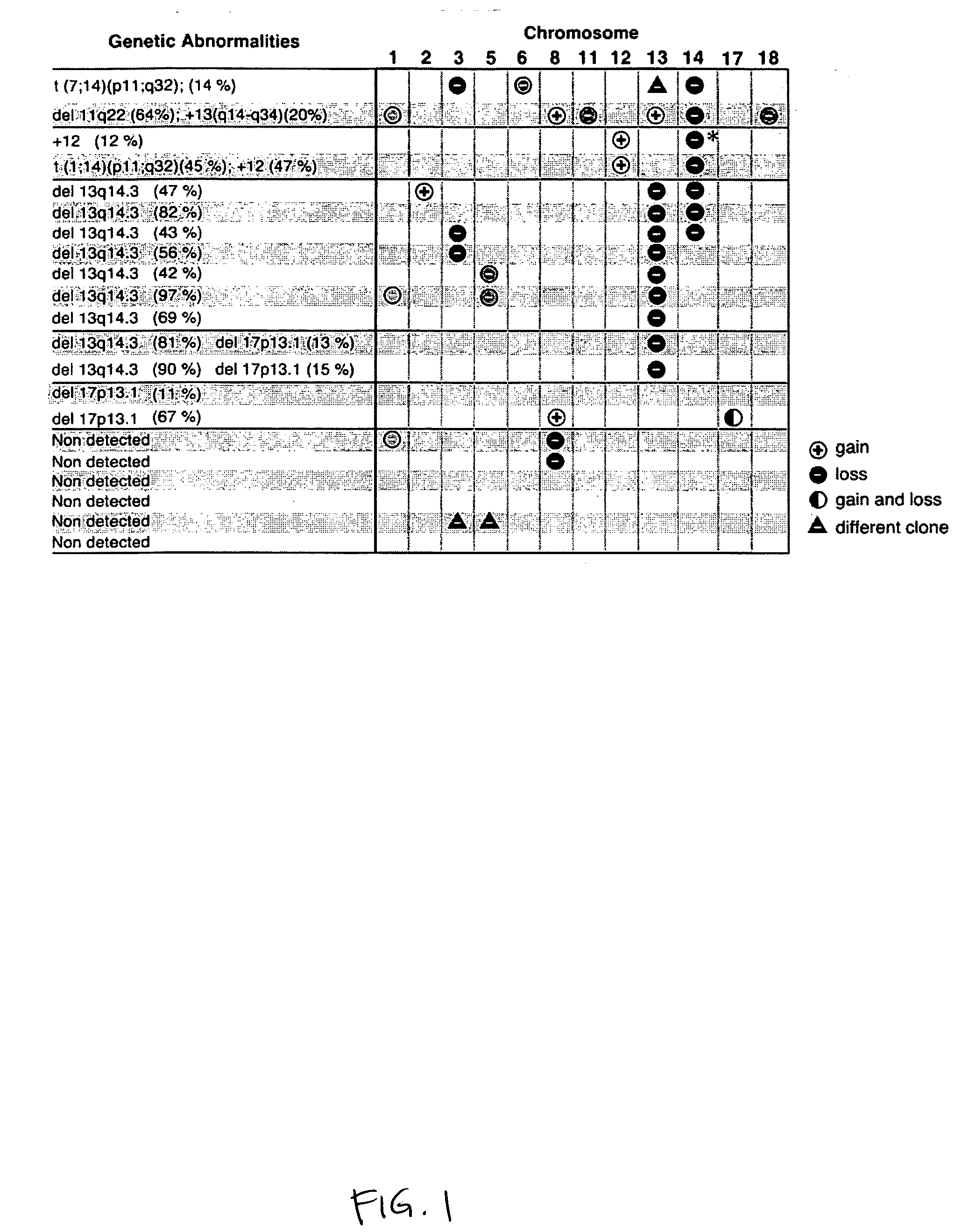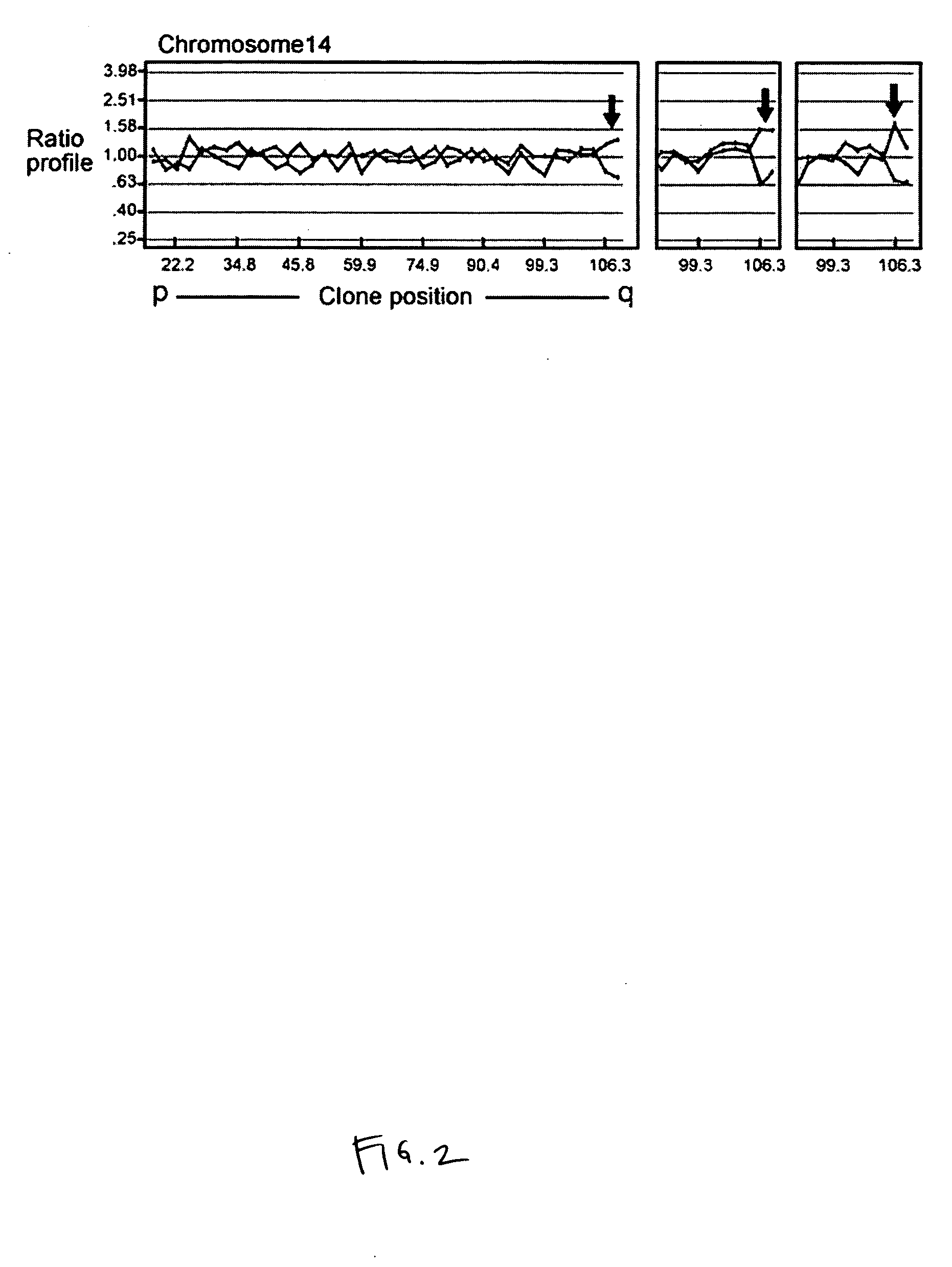Compositions and methods for diagnosing and treating chronic lymphocytic leukemia
a lymphocytic leukemia and composition technology, applied in the field of compositions and methods for diagnosing and treating chronic lymphocytic leukemia, can solve the problems of increasing the concentration of lymphocytes in the blood, and achieve the effect of poor prognosis
- Summary
- Abstract
- Description
- Claims
- Application Information
AI Technical Summary
Problems solved by technology
Method used
Image
Examples
example 1
Array-CGH in Comparison to FISH in CLL
[0191] Array-CGH analysis was performed using BAC (bacteria artificial chromosomes) clones spotted onto glass slide (Spectral Genomics) on 21 patients with CLL all of whom had their disease characterized by FISH. Array-CGH analysis confirmed the cytogenetic abnormalities previously characterized by FISH, but also revealed a number of cryptic abnormalities, many of which are shared among patients. Correlating the array-CGH finding with patient outcome data, a cryptic deletion at 14q23 was identified that appears to be associated with patient prognosis. The presence of this deletion was verified by FISH and extended this study to a larger cohort of patients.
[0192] The initial aim was to evaluate results obtained by array-CGH in comparison to those obtained by cytogenetics and FISH. The BAC arrays used consisted of 1003 clones, each clone containing 200-300 kb of genomic DNA fragments spotted in 12 duplicate sub grids onto glass slides. These arr...
example 2
Deletion 14q32.33 Confirmed by Interphase FISH
[0198] Three of the cases with deletion 14q32 were patients with deletions at 13q14.3 detected by FISH as a sole abnormality. Such patients generally have good prognosis. However, it was noted that all three of these patients had rapidly progressive disease, and hypothesized that the deletion 14q32.33 might be associated with poor prognosis. In order to confirm the presence of the deletion detected by array-CGH at 14q32.33 was real, and to validate that this might be associated with poor outcome, the BAC clone involved in 14q32.33 deletion was identified and prepared a cy3-dUTP labeled FISH probe from DNA isolated from the BAC clone (CTC-200D12). The BAC clones involved in all recurrent DNA copy number changes were identified by software analysis. BAC RP11-80H2 (chromosome 13q14.3-q21) was obtained from BACPAC Resources (Children's Hospital Oakland, Calif.) and GS-200D12 (chromosome 14q32.33) from Spectral Genomics. BAC DNA was isolated...
example 3
Identification of VH Deletions by Array-CGH
[0201] Array-CGH was performed on 21 previously untreated CLL patients with a variety of cytogenic abnormalities, including six patients with no detectable abnormalities. Array-CGH detected the majority of abnormalities detected by conventional cytogenetics and also revealed novel recurrent genomic imbalances (FIG. 1; the percentage of cells with each abnormality detected by conventional cytogenetics and / or FISH is indicted in parentheses). A total of 40 genomic imbalances (seven gains and 33 losses) on 12 chromosomes were identified by array-CGH, including 14 imbalances detected by the previous FISH analysis (FIG. 1; for each chromosome, aberrations involving the same BAC clone are indicated in the same color).
[0202] As expected, balanced translocations (2 cases) and 17p13.1 deletions occurring in 15% or less of the cells (3 cases) were not detected by array-CGH. All other abnormalities were confirmed by array-CGH, including 13q14, 11q22...
PUM
| Property | Measurement | Unit |
|---|---|---|
| temperature | aaaaa | aaaaa |
| temperatures | aaaaa | aaaaa |
| temperatures | aaaaa | aaaaa |
Abstract
Description
Claims
Application Information
 Login to View More
Login to View More - R&D
- Intellectual Property
- Life Sciences
- Materials
- Tech Scout
- Unparalleled Data Quality
- Higher Quality Content
- 60% Fewer Hallucinations
Browse by: Latest US Patents, China's latest patents, Technical Efficacy Thesaurus, Application Domain, Technology Topic, Popular Technical Reports.
© 2025 PatSnap. All rights reserved.Legal|Privacy policy|Modern Slavery Act Transparency Statement|Sitemap|About US| Contact US: help@patsnap.com



